Previously I wrote about setting out on my solo journey across Germany and how I prepared. Today I’m going to break down everything about my time in Berlin: places to visit and tons of photos to share. Along the way, I hope to share a few tips and tricks to make your visit enjoyable.
Arrival In Berlin
After a 12 hour flight I landed in Berlin at 8:20am. Thanks to the sleeping gummies I took, I was wide awake and my legs weren’t sore or stiff thanks to the compression socks I wore. As I exited the plane and made my way through customs, I took the escalator down to the bottom floor to the train station and awaited an RE train heading to Alexanderplatz. Once I reached Alexanderplatz station, I transferred to the U8 train for two stops to Rosenthaler Platz. I was arriving to Circus Hostel early and was familiar with their luggage policy so I proceeded to the front desk to get access to the locker room below. With my luggage and backpack tucked away and locked, I headed back to the subway and took a train back to Alexanderplatz and then to Berlin Hbf for some sight seeing.
For my own self-guided tour, I downloaded a Berlin City Walk guide in the Rick Steves Europe App. It is about 90 minutes long which I thought was the perfect length. The recommendation is to run the whole tour to get acquainted with the main attractions in Mitte for later pursual but I opted to simply pause the tour at each attraction to spend some time exploring it deeply. Overall I think the entire tour took me about four hours to complete.
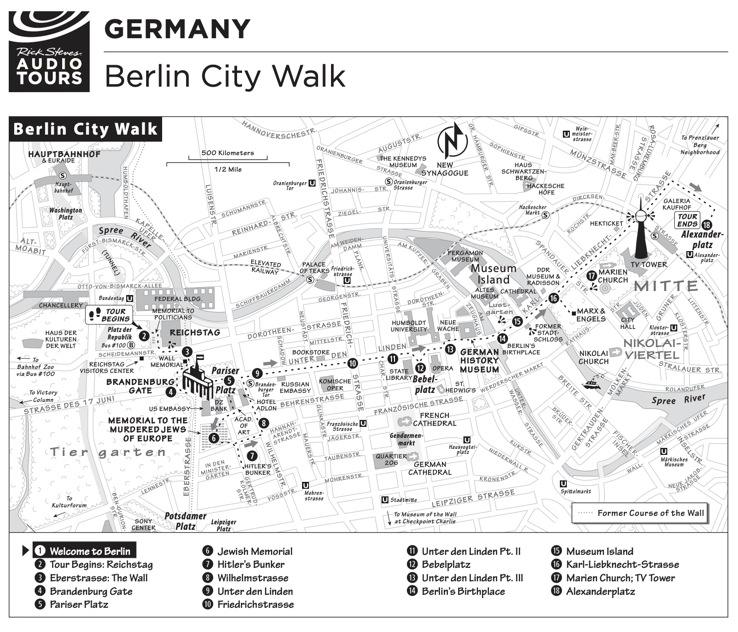
The tour is perfect because it starts right outside the Bundenstag station at the Reichstag ands ends at the Alexanderplatz station.
The Reichstag Building
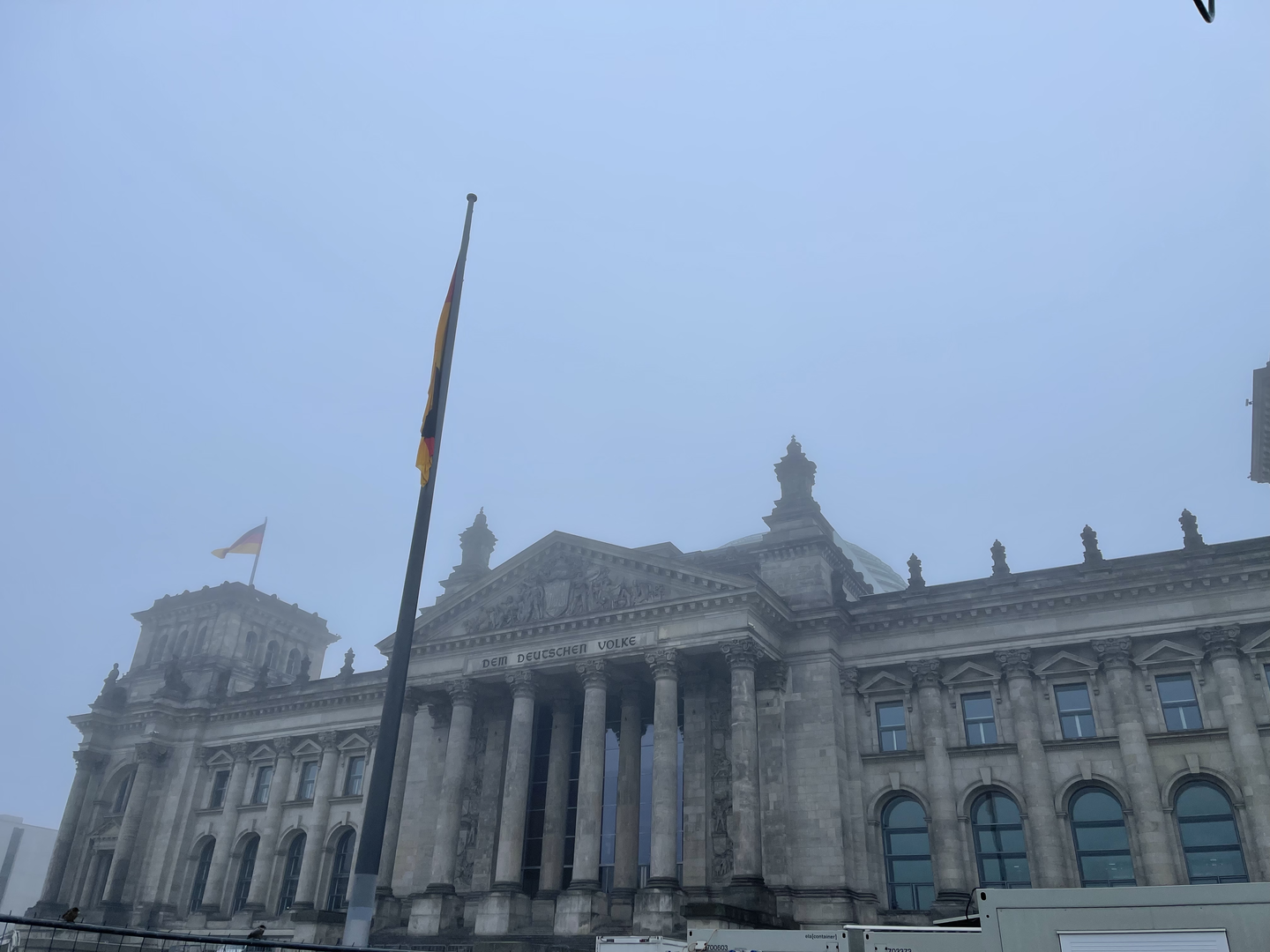
Unfortunately there was heavy construction going on directly in front of the Reichstag, so I was unable to get the really nice, broad shot of this historic building that I was hoping to get. Instead I had to settle for some close ups which provide for some beautiful detail against the foggy backdrop.
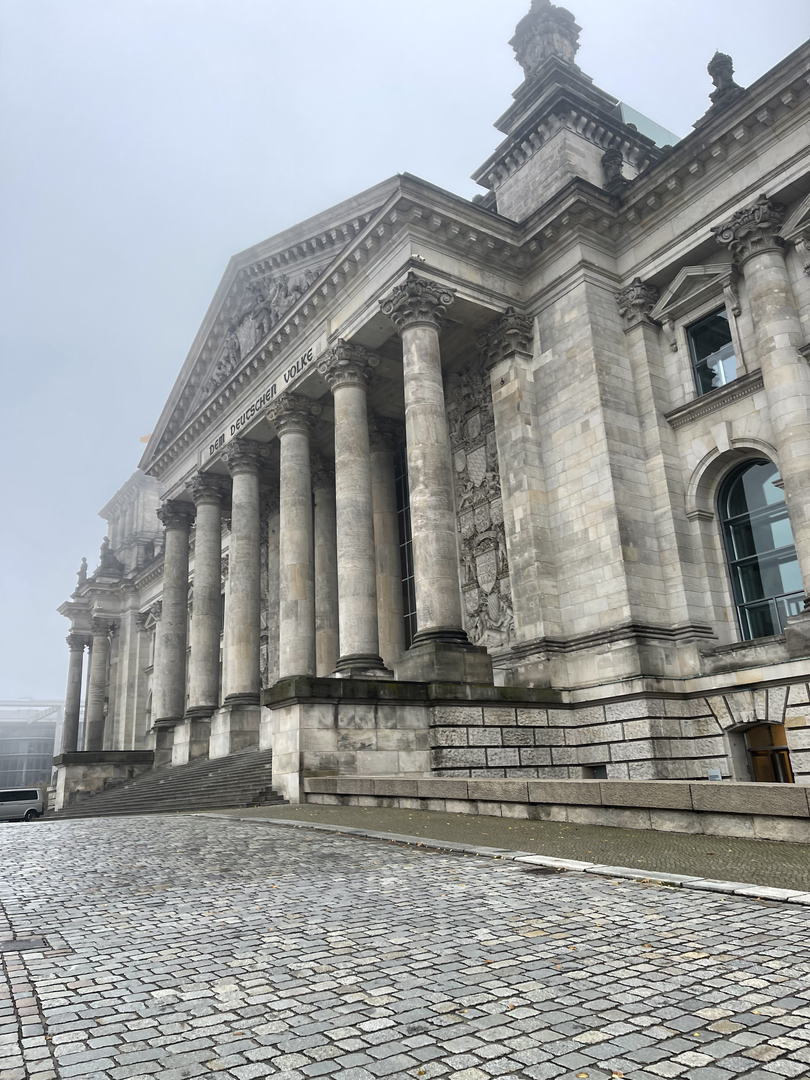
The Historical and Modern Significance of the Reichstag Building
The Reichstag building in Berlin stands as a testament to the tumultuous history and the enduring strength of German democracy. Constructed between 1884 and 1894, this Neo-Renaissance edifice, designed by Paul Wallot, originally served as the seat of the Reichstag (Imperial Diet) of the German Empire and later the Weimar Republic. It witnessed the pivotal periods of the German Empire (1871–1918) and the Weimar Republic (1919–33), playing a central role in the country’s legislative history (Berlin.de).
A crucial event in the Reichstag’s history, and indeed in world history, was the Reichstag fire in 1933. This incident occurred shortly after Adolf Hitler became chancellor and marked a significant turning point towards the totalitarian regime of the Third Reich. After suffering severe damage during the Second World War, the building lay dormant for decades, symbolizing the fractured state of the nation.
However, with the fall of the Berlin Wall and the subsequent reunification of Germany, the Reichstag was reborn. Architect Norman Foster led a meticulous restoration, completed in 1999, turning the building into a modern emblem of unity and democracy. Since April 19, 1999, the Reichstag has proudly served as the home of the Bundestag, the national parliament of the reunited Germany, marking a new era in its storied existence (History Hit).
Today, the Reichstag is not just a functioning part of Germany’s political landscape but also a symbol of its turbulent past and hopeful future. It stands as a reminder of the resilience of democratic values in the face of adversity and change.
The Reichstag Dome
Since I snoozed on getting admission tickets until it was too late, I grabbed breakfast reservations for the restaurant on the roof next to the dome. This allowed me to pass through security and take an elevator to the rooftop, where I was able to explore the Reichstag Dome on my own.
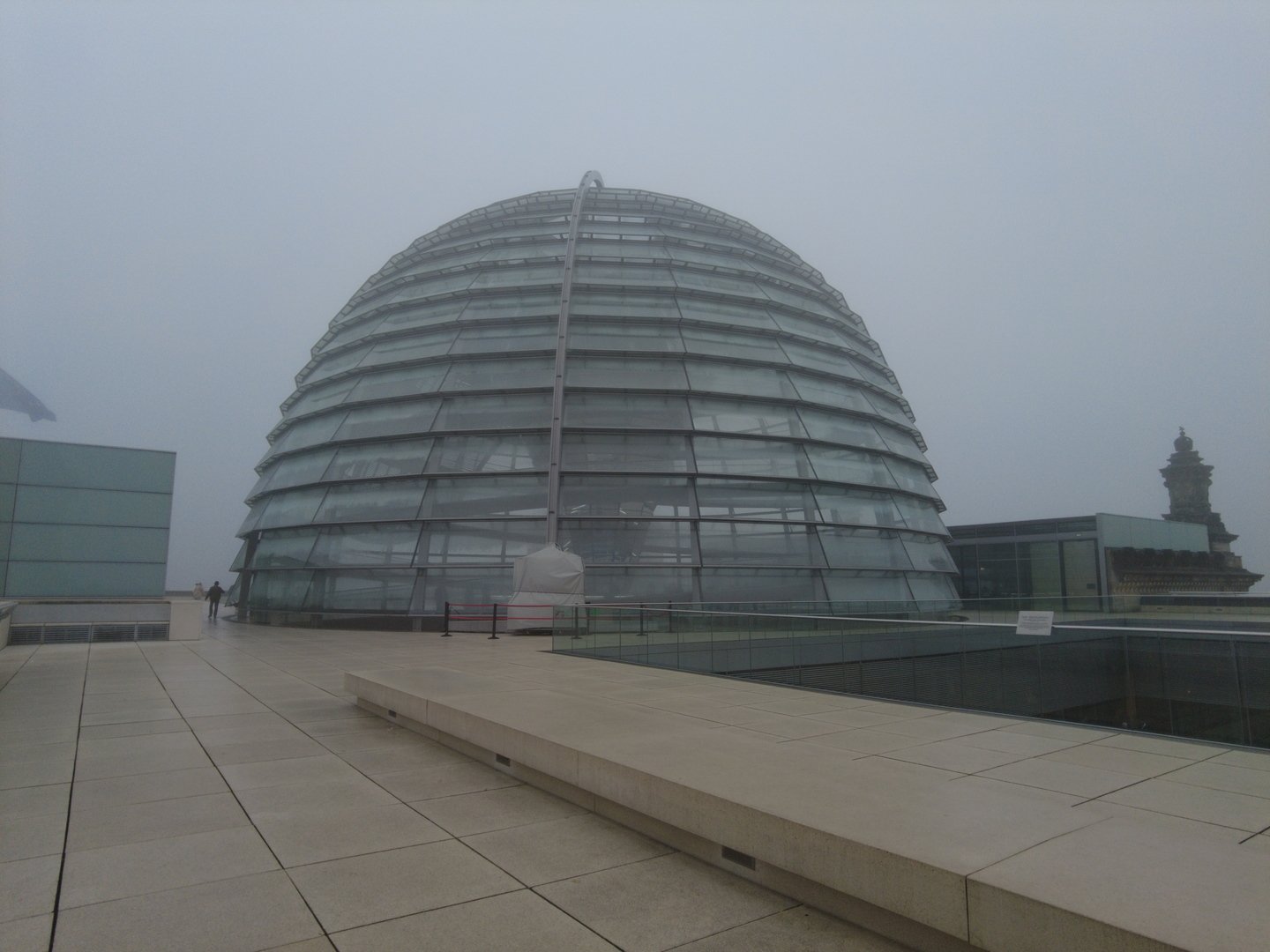
Photos don’t really do it justice, it just doesn’t quite capture the immense size of the dome when you first see it. Entering the inside of it reveals a spiral walkway to the top, with the middle containing a column of mirrors surrounded by historical details of the building from it’s original construction to present.
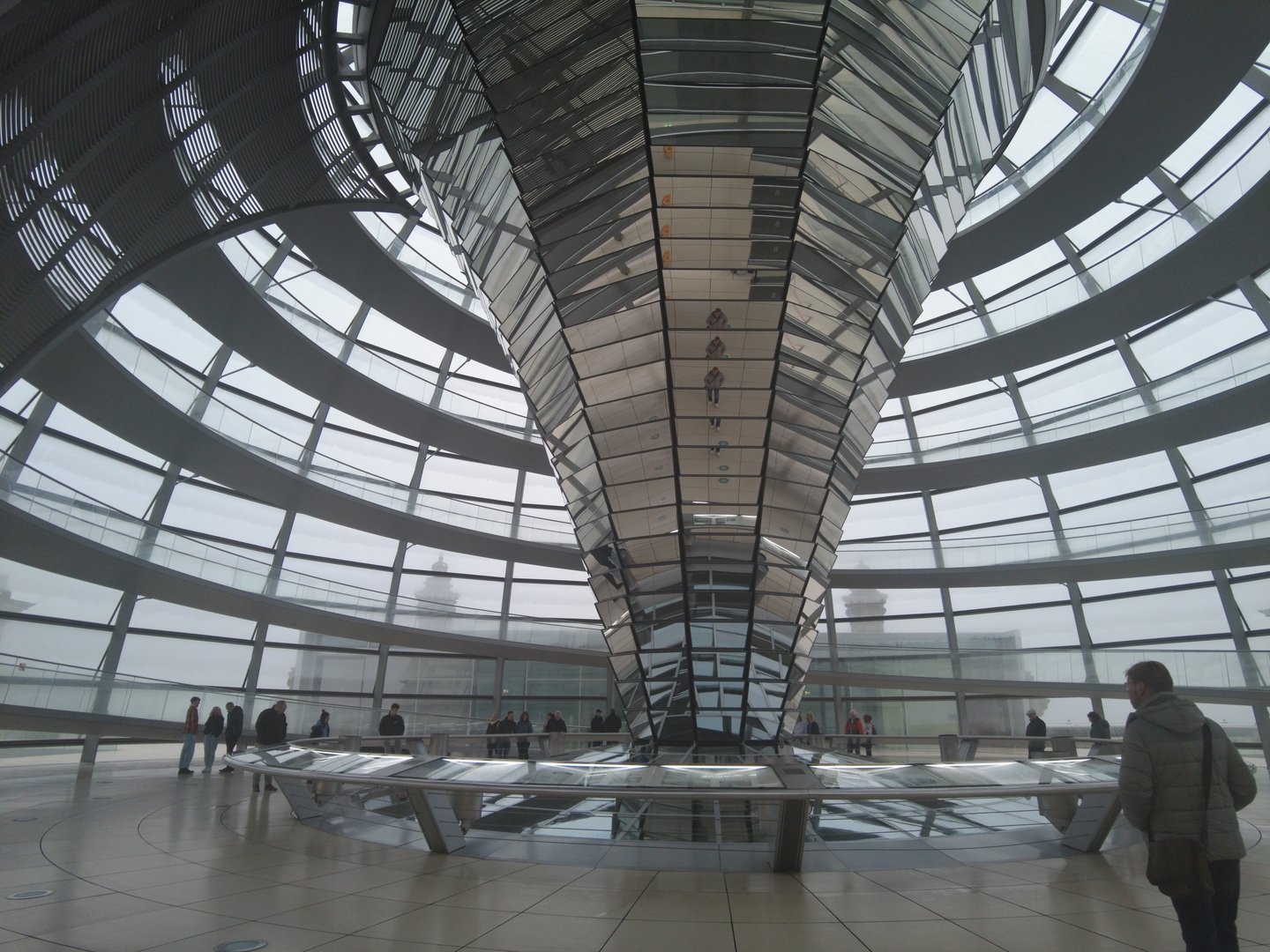
I had shown up 15 minutes early, so this allowed ample time for me to read the displays and stroll to the top of the dome and back down. Despite the foggy morning the view was still very beautiful.
Afterward I had breakfast at the restaurant, which basically has three different options to choose from. I went with the first option, enjoyed the croissant and coffee. To be fair, the meal wasn’t great but sufficient. It definitely isn’t representative of the cuisine you’ll find in Berlin and the real draw is access to the dome, not the meal.
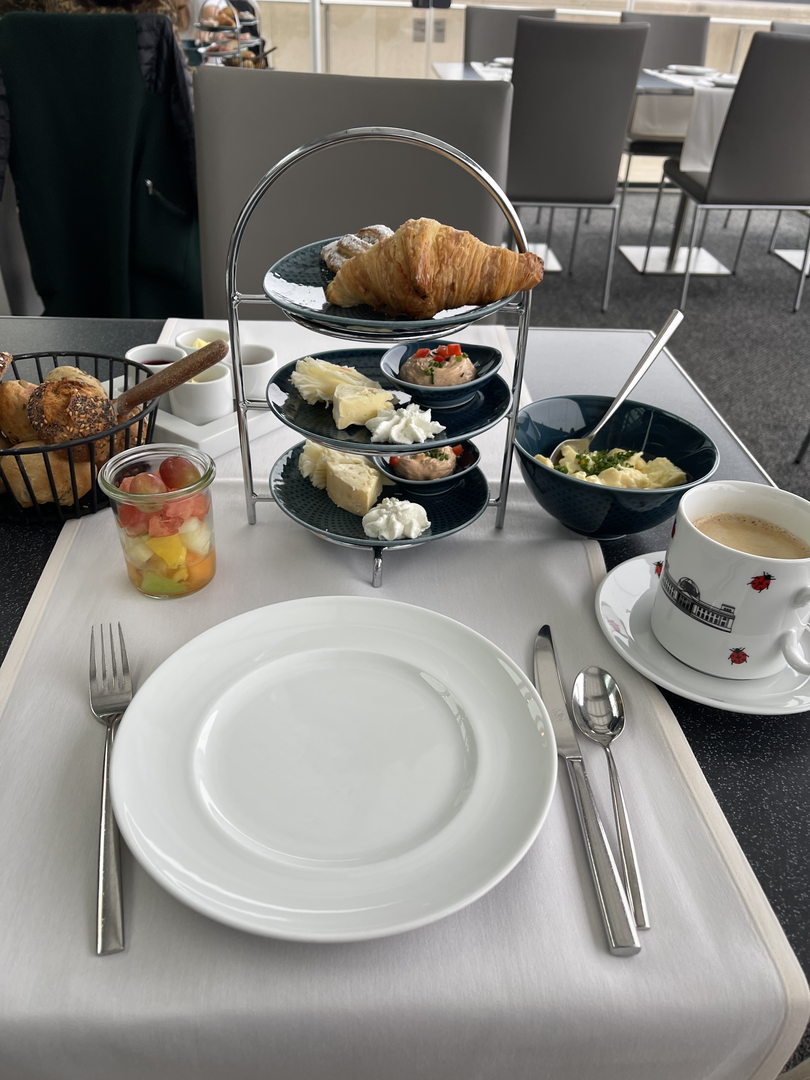
And yes, they did give me two plates of cheese here. I noticed others had a plate of meats but I didn’t care too much. I enjoyed the eggs, croissant and coffee and was quickly on my way.
Brandenburg Tor
Afterward, I continued across the street to the left of the Reichstag under a row of beautiful yellow leave trees to make my way to Brandenburg Tor. I passed underneath of it and stopped in front to listen to my audoguide tour explaining the design and history of the monument that everyone thinks of when they think of Berlin.
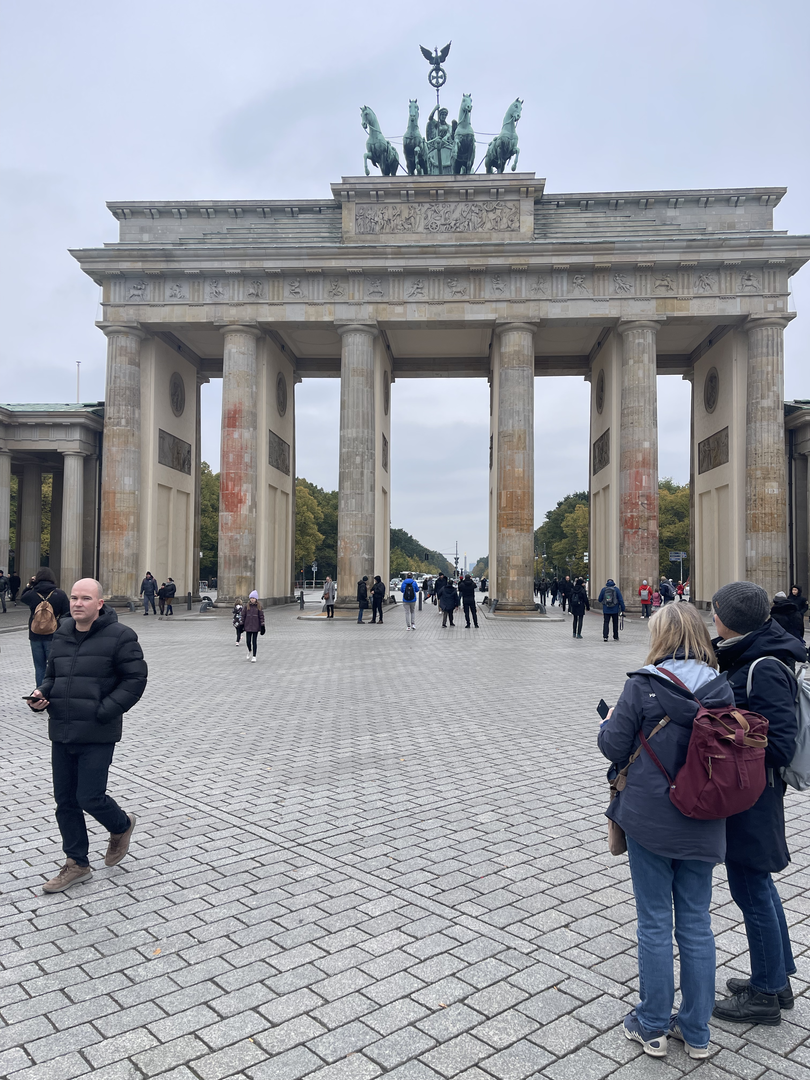
Architectural Details and History
The Brandenburg Gate (Friedenstor) was commissioned by Frederick William II of Prussia and reflects a rich blend of historical events and architectural brilliance. Designed by Carl Gotthard Langhans, this iconic structure was built between 1788 and 1791 as a part of Langhans’ grand vision for Berlin.
The gate’s design, a combination of Roman and Greek architectural styles, showcases twelve fluted Doric columns that create five passageways. Its intricate reliefs, inspired by the Labours of Hercules, and design elements reminiscent of the Acropolis of Athens, make it a remarkable example of the Greek Revival architecture in Germany.
Atop the gate is the stunning quadriga, a bronze sculpture of a chariot drawn by four horses, created by Johann Gottfried Schadow. This sculpture, led by Victoria, the goddess of victory, faces Berlin’s city center, symbolizing the triumph of peace.
The Brandenburg Gate has been a silent witness to pivotal historical events. Notably, after the Battle of Jena-Auerstedt in 1806, Napoleon took the quadriga to Paris. Its return and restoration in 1814 by Karl Friedrich Schinkel marked its transformation into a Prussian triumphal arch, reinforcing its symbolism as a beacon of victory and peace.
When I was nine years old it was the most prominent backdrop of all the protests that were held before the Berlin Wall was torn down.

Here is the view from the same area today.
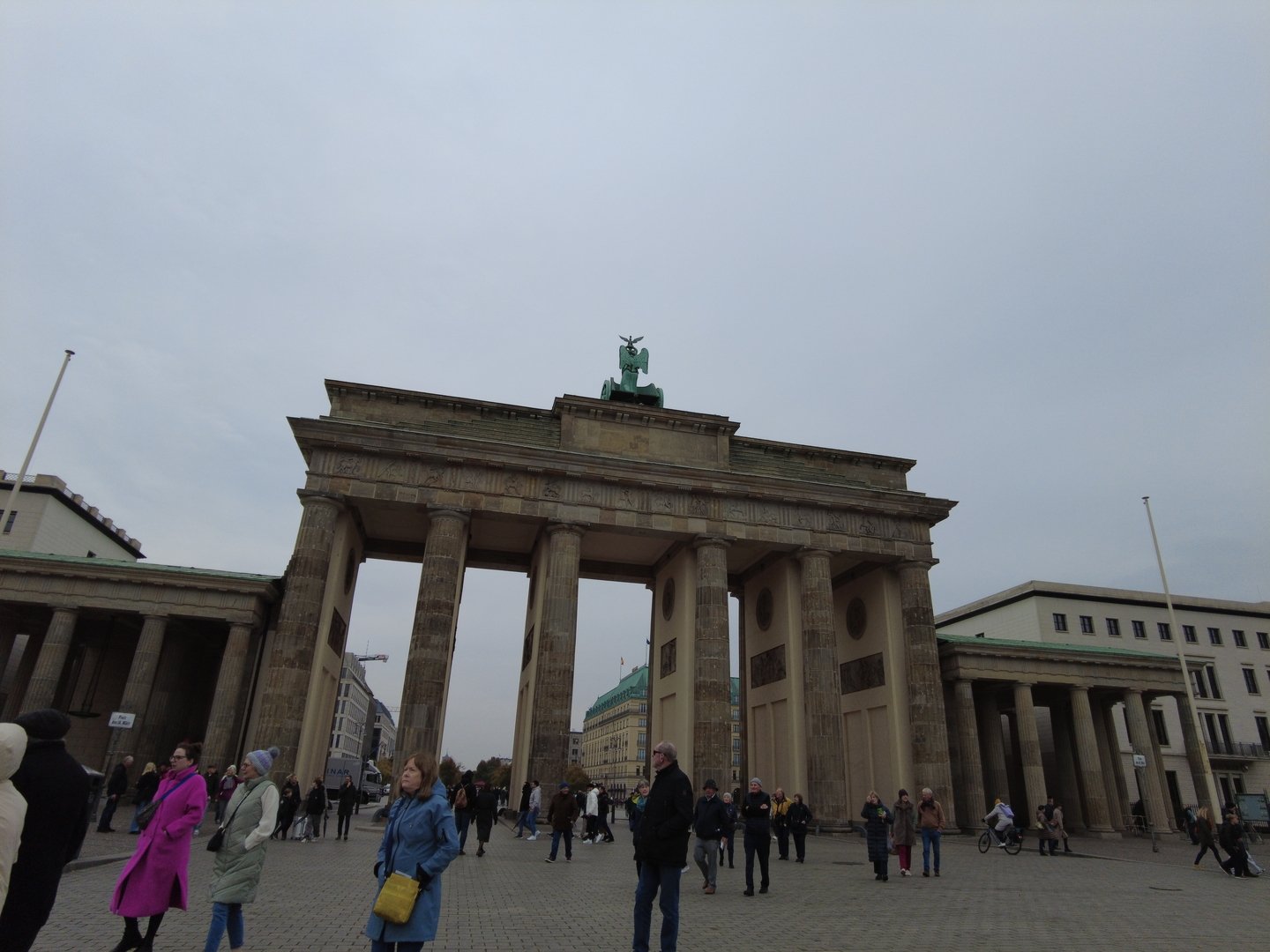
Unter den Lindon
Walking eastward Brandenburg Tor I continued down Unter den Lindon, the major boulevard stretching eastward.
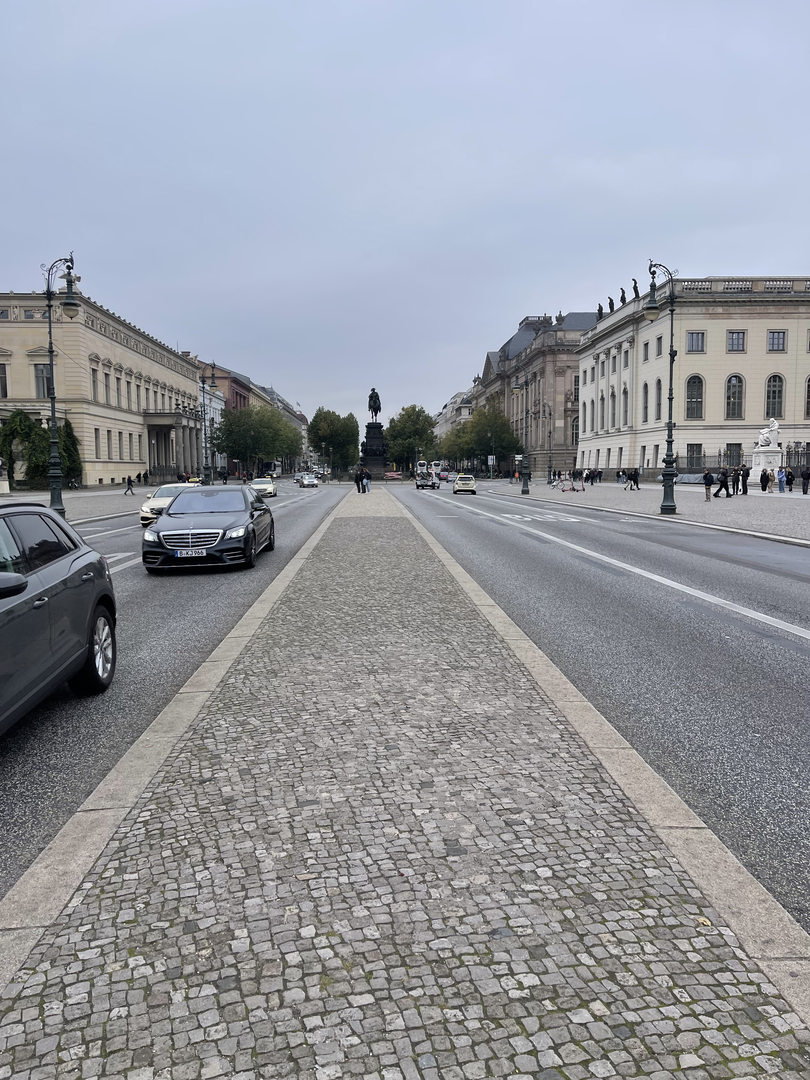
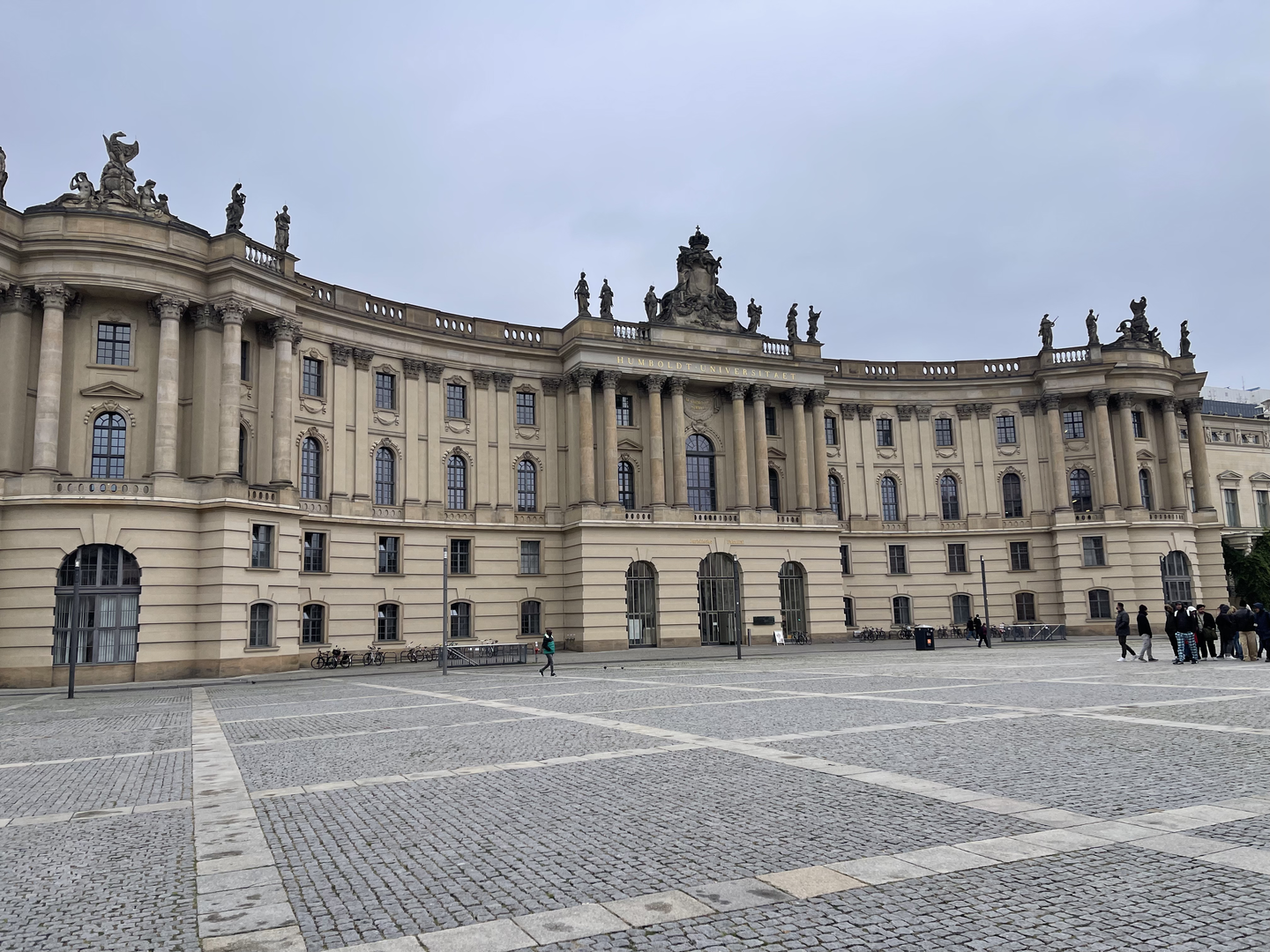
I continued walking down Unter den Lindon as I listened to my audio tour. The Amplemanchen Gift shop made for a perfect place to stop and grab a couple souvenirs for the kiddos. Resuming the tour, I made my way to Bebelplatz, which was the location of the infamous Nazi book burnings. At the center of the platz is a memorial titled “The Empty Library” which is a glass window on the ground in the center of the square, which when you look down is a room filled with empty book shelves. On a plaque in front of the memorial is etched the following message
That was but a prelude;
where they burn books,
they will ultimately burn people as well.
I took a moment to quietly contemplate the area. After stopping by the memorial to victims of war and violence across the street, I continued walking eastward to Museum Island.
Museum Island
Museum Island is home to the Berlin Dom as well as a large variety of museums. I had actually bought a day ticket for all of these museums, so I made my way to the Altes Museum on my left.
The Altes Museum
Altes Museum was first on my list given I had timed tickets for other things. What is nice about this one (and all of them really) is they lockers available for storing belongings. I had a front facing bag on me that I stored here for two euros as I continued sight seeing. I placed the key in my pocket and left the bag here for the remainder of my time at the museums so I wouldn’t have to store it each time.
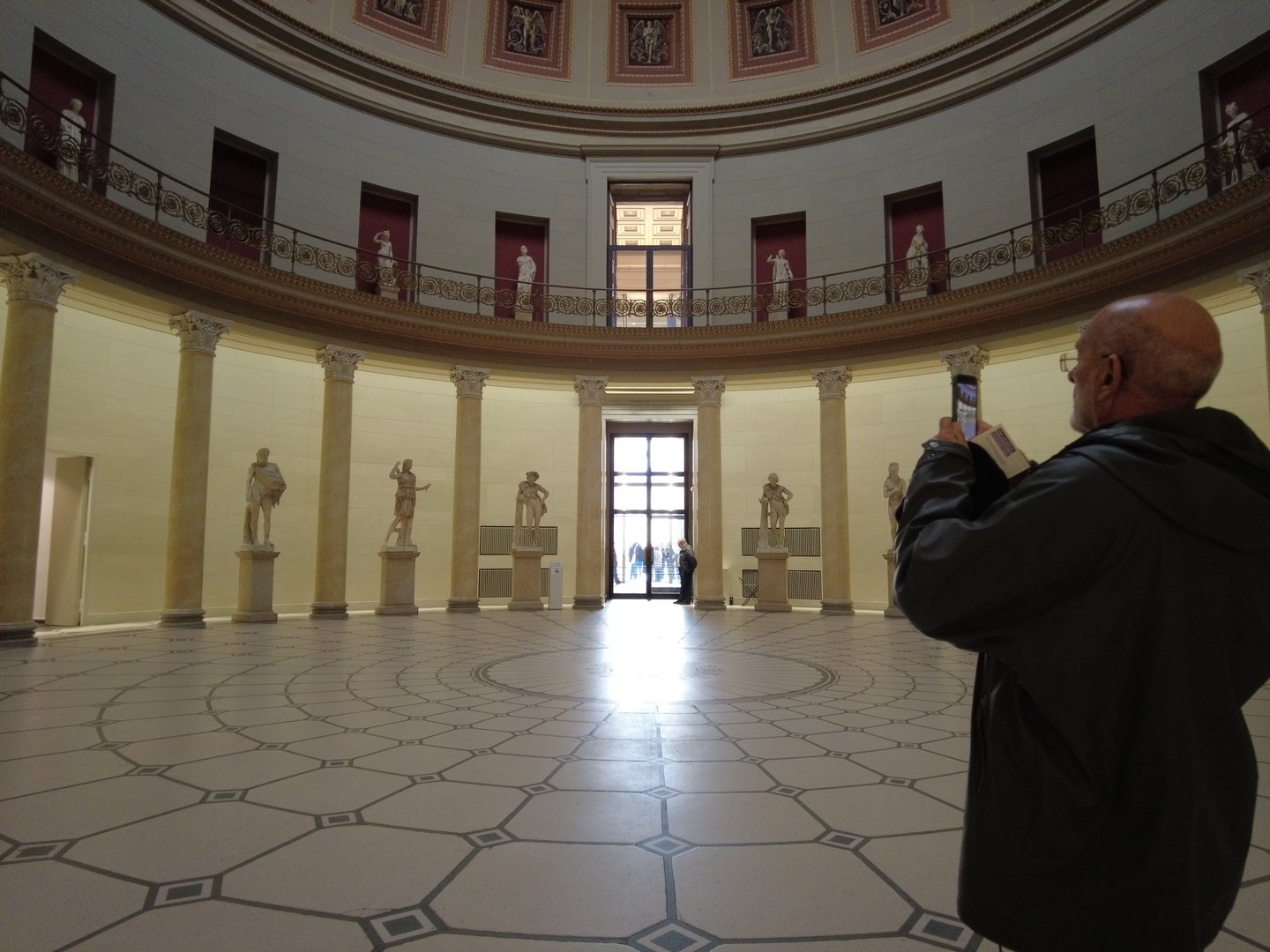
The Altes Museum is a renowned historical and cultural landmark, celebrated for its magnificent neoclassical architecture and esteemed collection of antiquities. Designed by Karl Friedrich Schinkel and opened in 1830, the museum stands as a prime example of neoclassical design, featuring an iconic colonnaded portico that evokes the grandeur of ancient Greek temples. The museum’s extensive collection primarily focuses on classical antiquities, showcasing a rich array of artifacts from ancient Greece and Rome. This includes sculptures, pottery, jewelry, and other items that offer a comprehensive insight into the art, culture, and daily life of these ancient civilizations. The museum’s layout and the display of its collections are thoughtfully arranged to enhance the visitor’s journey through the historical narratives of these bygone eras.
I took it slow walking through this museum, soaking up in all the classical greek sculptures. After exploring this museum for 45 minutes, I made my way to the Berlin Dome for my timed entry window.
Berlin Dome
Adjacent to the Altes is the Berlin Cathedral. It is well known for its elaborate and ornate design and stands out the most as you approach Museum Island. As you approach, you may see everyone suddenly freeze and whip out their phones to take photographs as soon as it comes into view. You might take a few minutes for some photos and selfies as well.
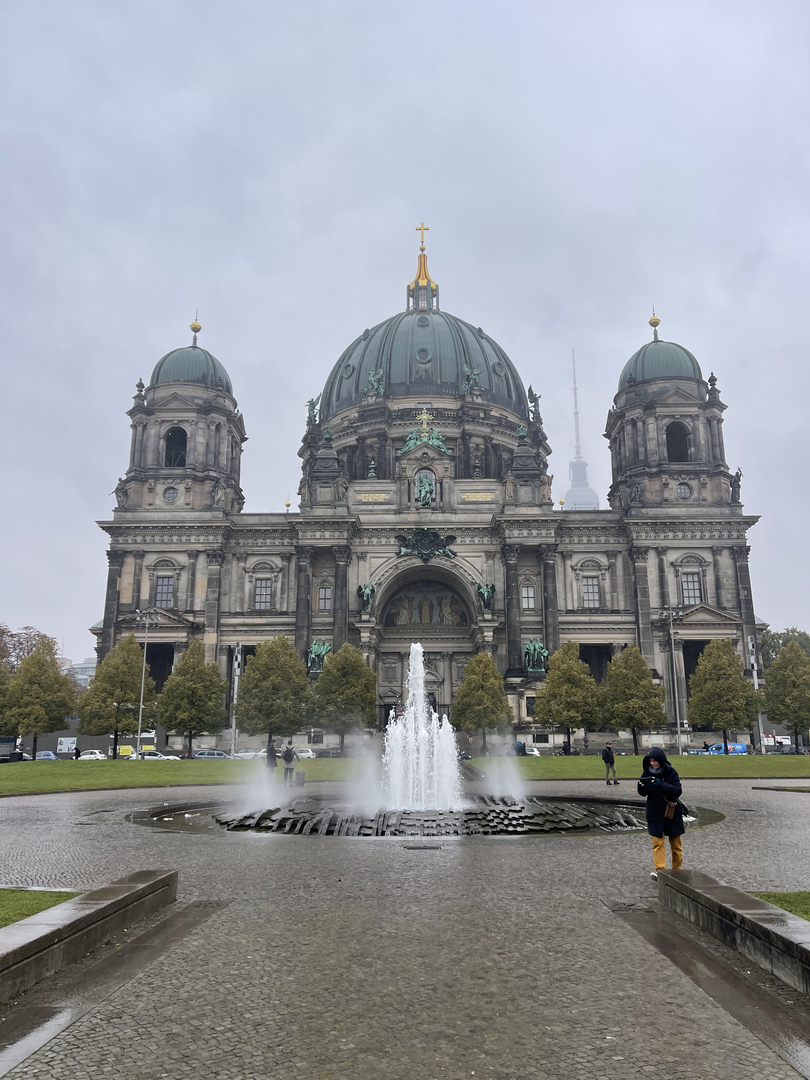
The Berlin Cathedral, officially known as the Berliner Dom, is a magnificent religious edifice and a historical landmark in the heart of Berlin, Germany. Initially constructed in the early 20th century on the site of earlier churches, it serves as a prominent example of Protestant church architecture in Germany. It holds significant historical importance and is a key tourist attraction, offering not only religious services but also guided tours and concerts. Inside, visitors can explore its vast interior, which includes a richly decorated main hall, the Hohenzollern crypt containing royal tombs, and an impressive pipe organ.
The dome of the Berlin Cathedral is particularly noteworthy for its striking architecture. Designed by Julius Raschdorff, the dome is an iconic feature of the Berlin skyline, standing at a height of about 115 meters. Its design is a blend of Renaissance and Baroque styles, which is somewhat unusual for Protestant churches. The dome is adorned with intricate mosaics and offers a panoramic view of central Berlin from its outer walkway, accessible to visitors. The combination of its copper-green color, the grandeur of its size, and the ornamental details make the dome a remarkable architectural achievement and a symbol of Berlin’s rich history and cultural heritage.

The altar at the front of the Berlin Cathedral is a stunning exhibition of artistic achievement, a tribute to human creativity and the pursuit of aesthetic excellence. Framed by a backdrop of sumptuously veined marble, the altar itself is an ensemble of visual storytelling, with the dramatic central panel capturing a pivotal moment in Christian narrative—stripped of its spiritual context, it stands as a testament to the artist’s skill and the emotive power of visual art. Flanking this centerpiece are additional tableaus, each a meticulous work of art, harmoniously integrated into the golden splendor that adorns the space. Above, a circular stained-glass window filters the daylight, casting a kaleidoscope of colors that dance across the gilded surfaces and intricate carvings. This convergence of art and architecture creates a spectacle of light and shadow, form and detail, that transcends religious divides. The grandeur of the arches and the finesse of the relief work overhead contribute to a narrative of human ingenuity—a space that, regardless of one’s beliefs, commands a pause and appreciation for the ingenuity of its creators.
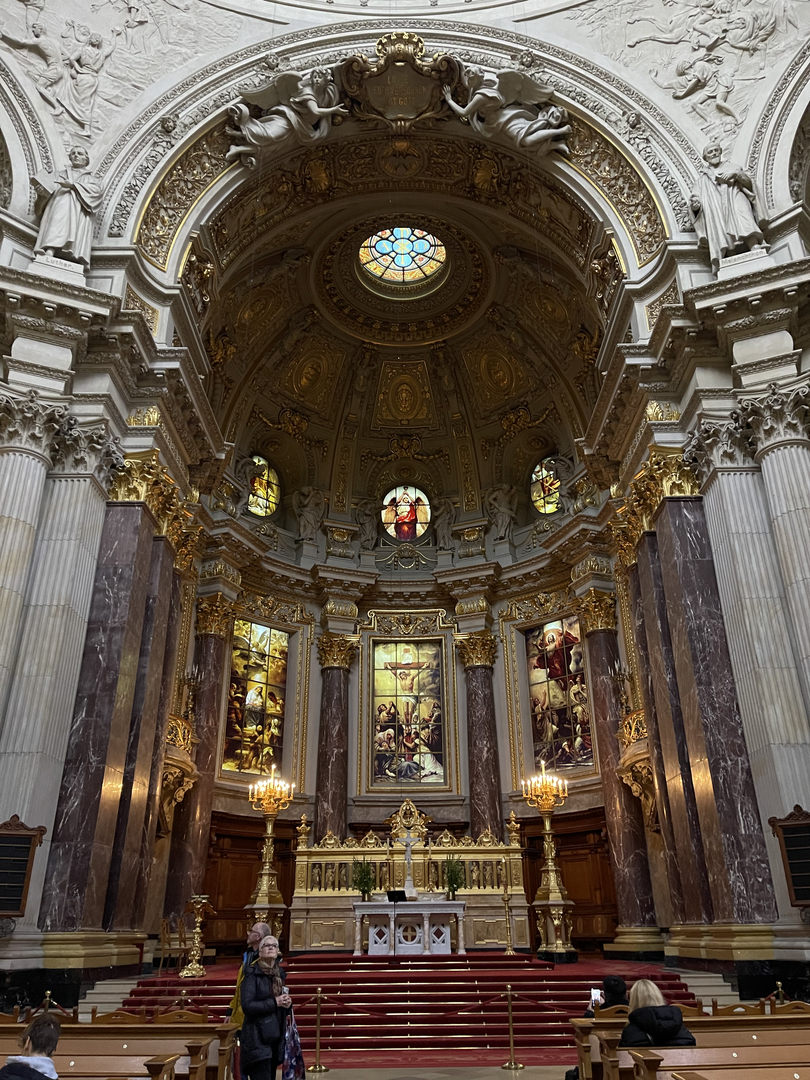
I sat down and took the architecture. The designs were truly breathtaking and the sheer size of it cannot be captured by photo or video, it really has to be seen in person to really take it in. Afterward, I exited through the cafe in the basement.
Pergamon
The Pergamon Museum was chief on my list of museums to visit since the days I was there would be the final days it would be open before closing for renovations for 14 years. Perfect benchmark to revisit and take stock of how much my life changes 14 years from now in 2037.
This museum houses the gorgeous Ishtar Gate, which required a timed entry ticket to access. It is really quite breathtaking.

I explored the rest of the Pergamon Museum and the various Babylonian and Egyptian exhibits on display.
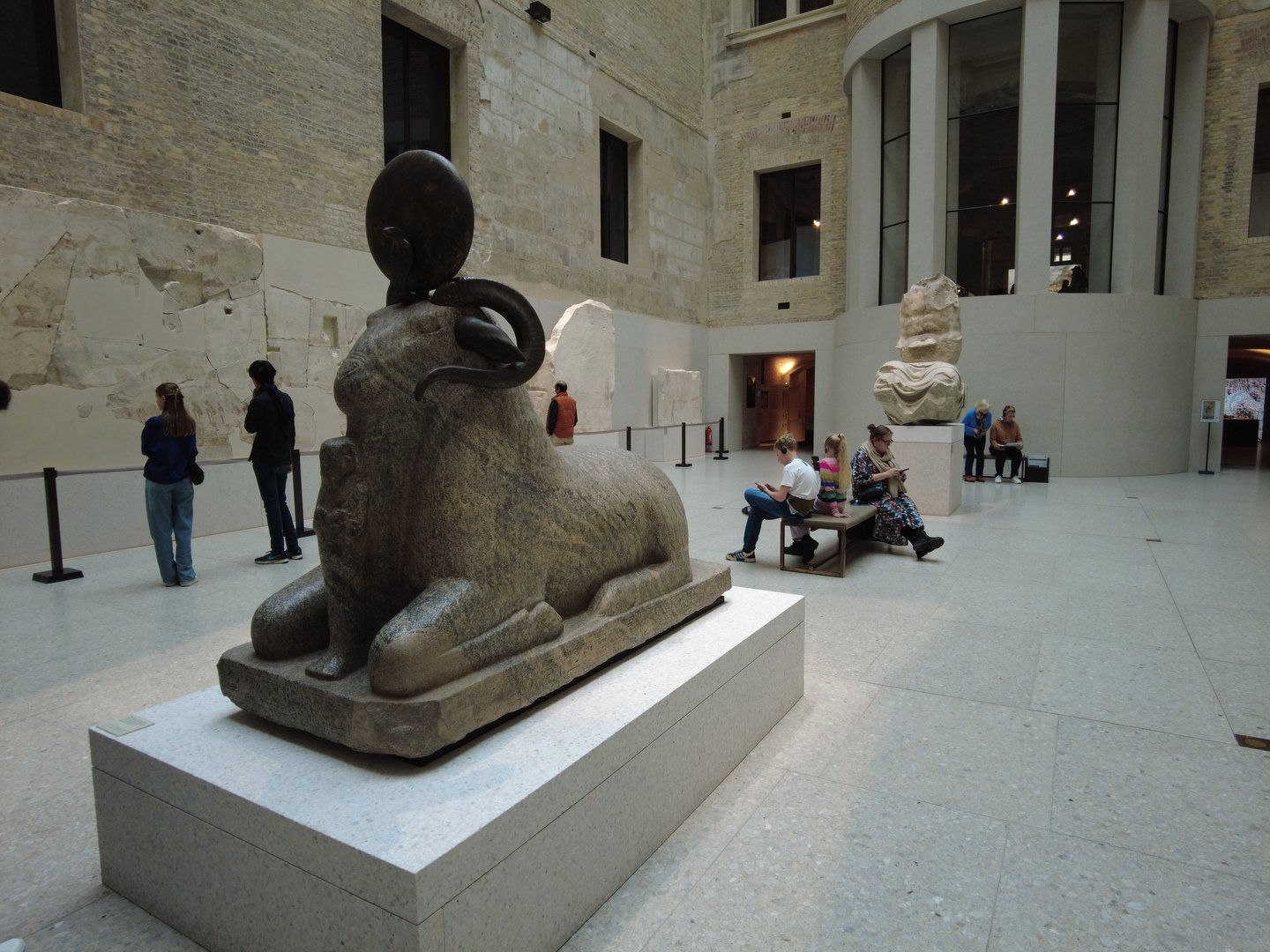
Memorial to the Murdered Jews of Europe
Before continuing down Unter den Linden, I followed the audio tour on a slight detour to visit the Memorial to the Murdered Jews of Europe. My audio tour actually had me pass through a building next to the Brandenburg Gate to reach it.
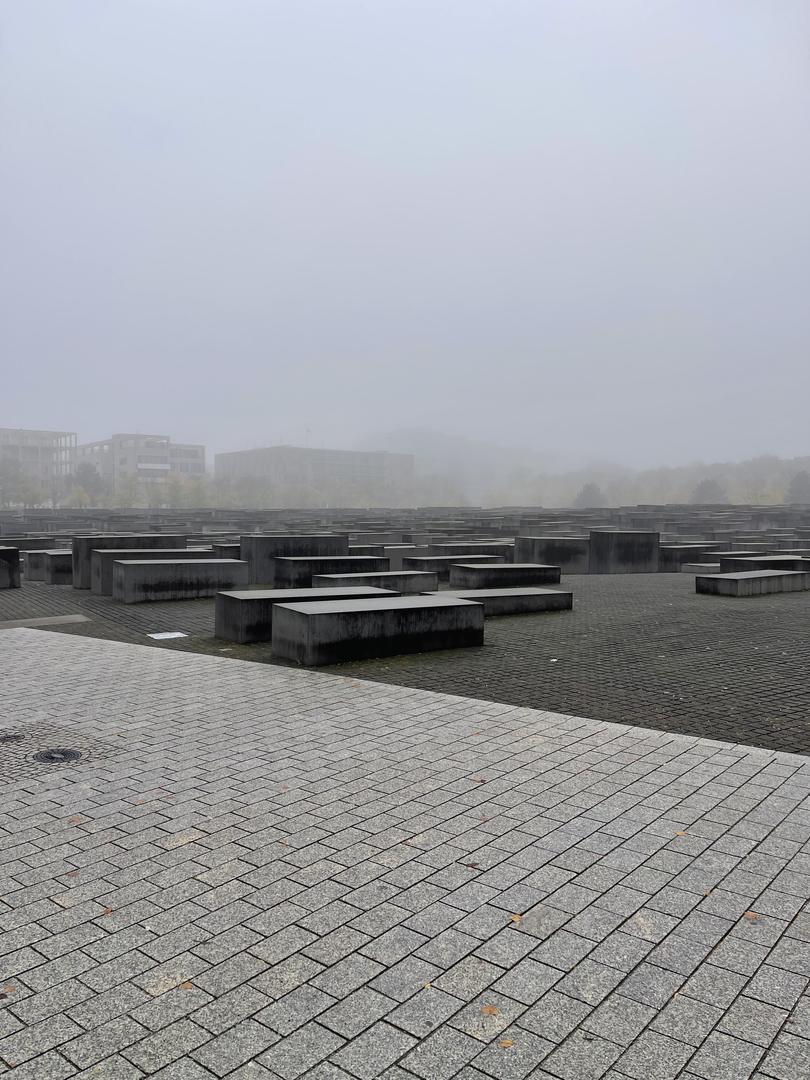
I walked slowly between the stelae, listening intently to the audio tour guide describing the memorial and Germany’s complex relationship with its horrific past. I pondered what life must have been like for Germans in Nazi Germany, who turned a blind eye to the atrocities committed against the Jewish community. This reflection led me to consider how similar indifference could be present in our society today, highlighting the importance of being vigilant about the dangers that can lurk within our own communities with regards to systemic discrimination.
Checkpoint Charlie
At this point I hopped on a Lime and made my way several blocks down to Checkpoint Charlie. This was the famous U.S. Army checkpoint between east and west Berlin after the end of World War 2 and would become a key locate for defectors to the west. It immediately looked familiar to me from being depicted in many spy movies during the cold war era.
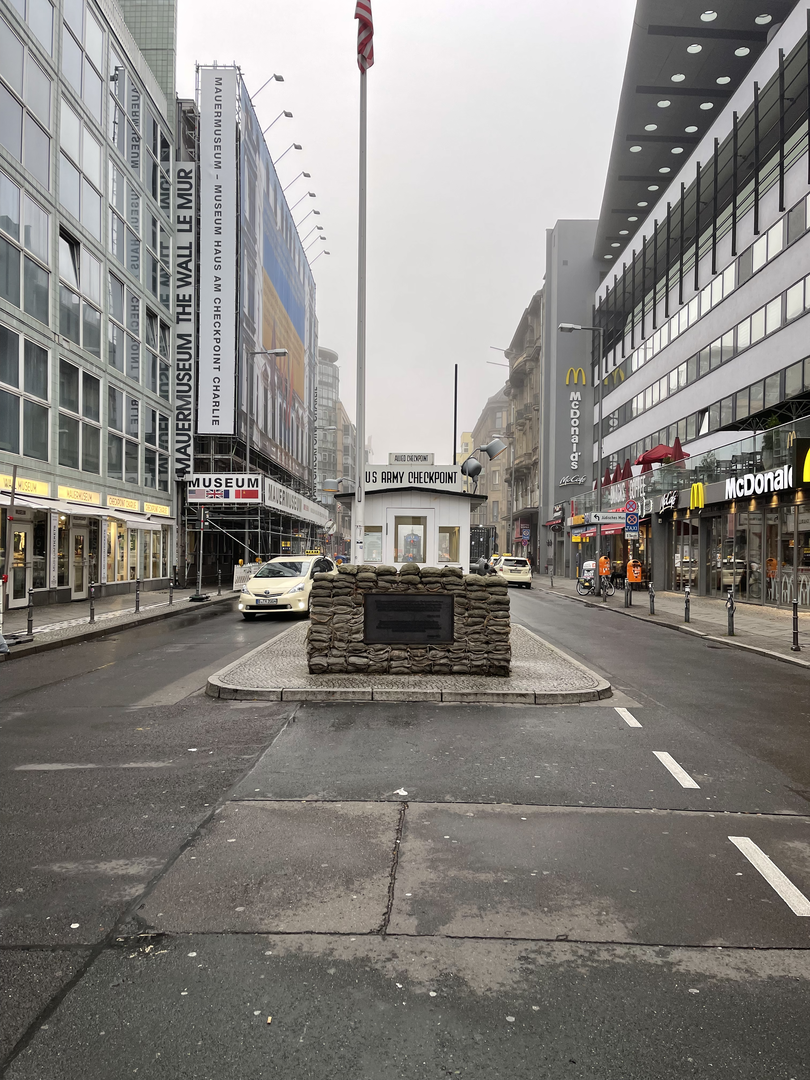
I snapped a few photos and explored the nearby area a bit, then once the audioguide finished I paused and made my way back to the next destination.
Pedestrian Lights

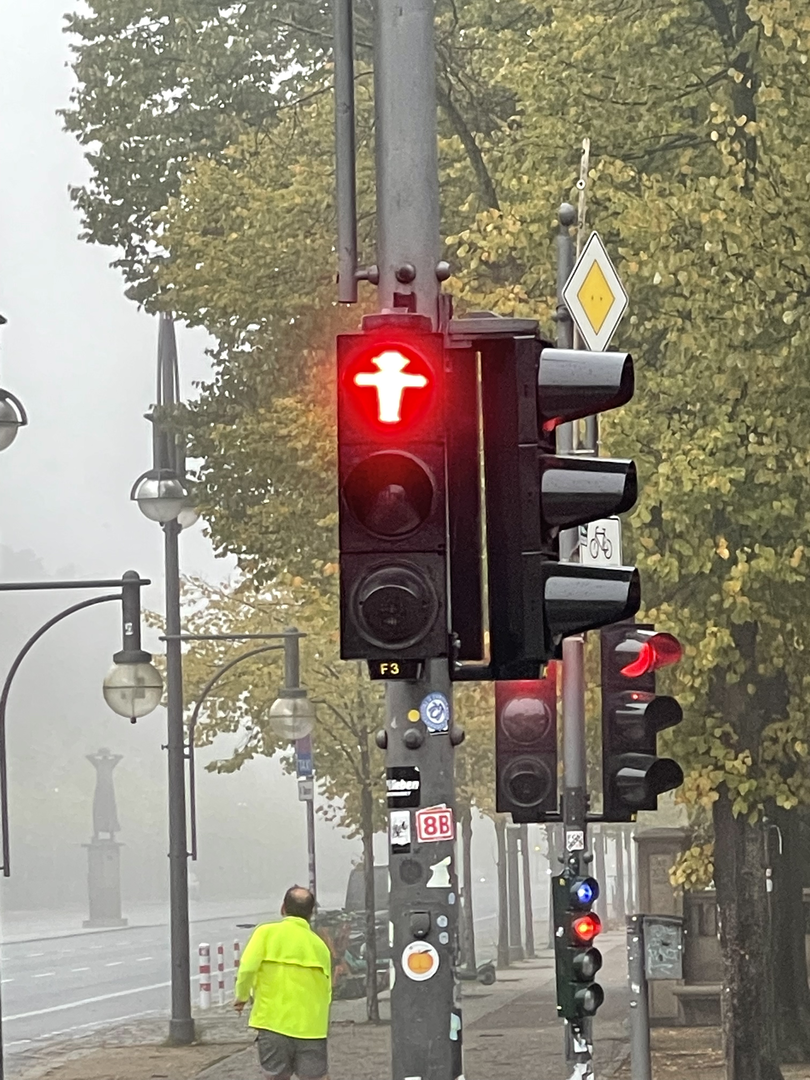
Something that is undeniably cute about Berlin are the unqiue light fixtures at pedestrian crosswalk. Ampelmännchen as he is lovingly called, is a kind of cultural icon for the city. You’ll find lots of Ampelmännchen merchandise around shops in Berlin, of which I picked up a T-shirt and book for the kids.
Other Observations
******Pipes******
One thing that really stood out to me as I traversed the city was the numerous pipes that were all over, sometimes in blue, red and other colors.
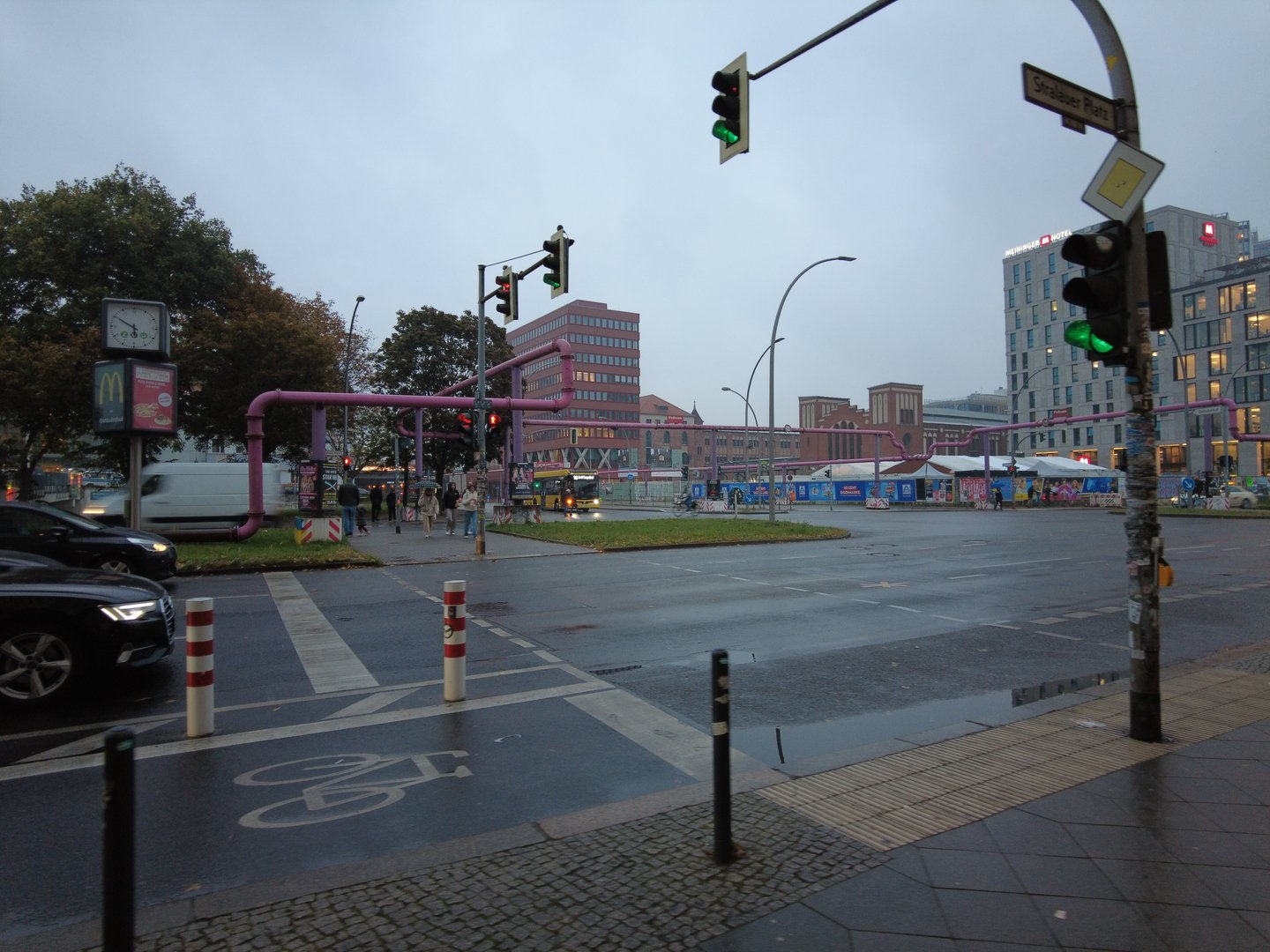
I was curious why this is so looked online to figure out why. Long story short, Berlin is actually built on top of marshes with a to of natural groundwater below the surface. The pipes are used to extract groundwater without flooding the city.
Food
I honestly didn’t do much in the way of food during my time in Berlin, which is a real bummer because it does have a lot of great dining options. I didn’t take out my camera for most of my meals because it feels weird, but I did snap a few photos worth sharing.
Currywurst
The famous street food of Berlin is Currywurst and as a result you’ll see it sold pretty much everywhere. My favorite booths are the ones with the cute Berlin Bears statues next to them. However like most street food, it can be hit or miss.
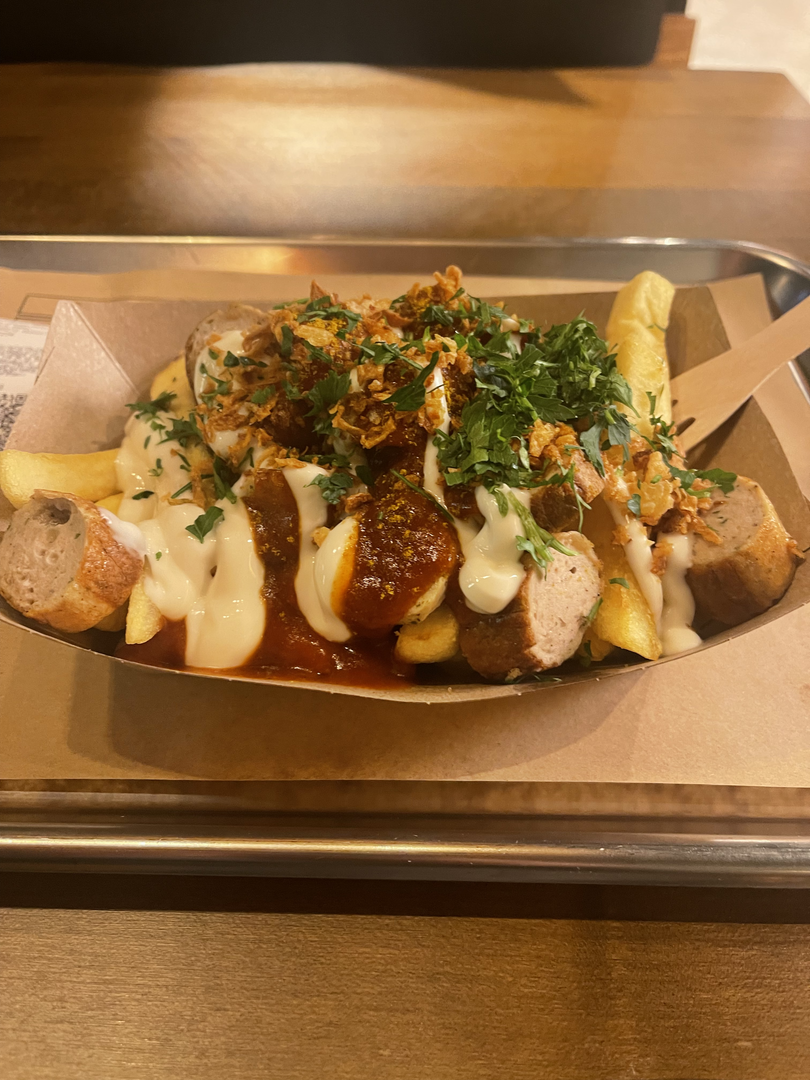
This is the one I had across the street from Circus Hostel before I turned in for the day. It was tasty but kind of heavy. Good thing I packed those Tums!
Cuisine
I found Berlin to be very very different from Rome in terms of dining options. It is a very modern, cosmopolitan city and I was even told I would be hard pressed to find German Cuisine and should instead enjoy all that Berlin had to offer. Here are some of note:
- Wen Cheng - If you like noodles, this was a must visit. Three locations across Berlin it is hard to miss.
- Pho Co - Both traditional and fusion Vietnamese dishes.
- Max und Mortiz - Relaxed, old-timey bar & restaurant, established in 1902, with a local German menu & a ballroom. Reservations required
Circus Hostel
Once I wrapped up most of my sight seeing around Museum Island, it was well past time for me to be able to actually check in to the hostel. I took the train back to Rathausplatz and walked a few yards to Circus Hostel. Checked in, got my key and a ticket for one free beer, got my luggage out of storage and made my way up to the room on the second floor.
Honestly, I thought the room looked better than I expected for a hostel. It was small with a desk, closet, safe and trash cans. There were several USB outlets in addition to standard type f electrical outlets. A small private bathroom adjacent as well, which is nice because last time I stayed in a hostel it had a shared bathroom with the floor, which was awkward.
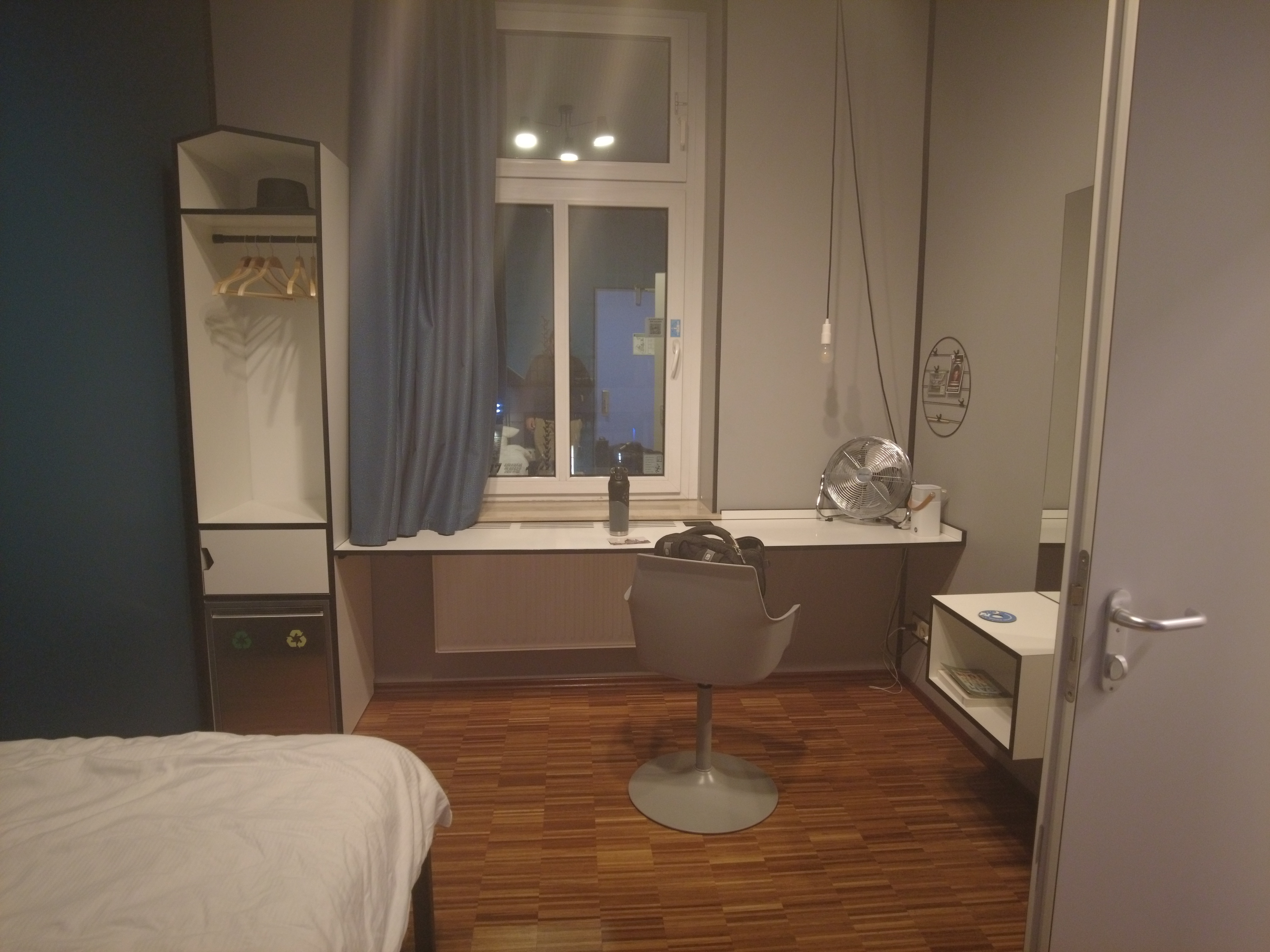
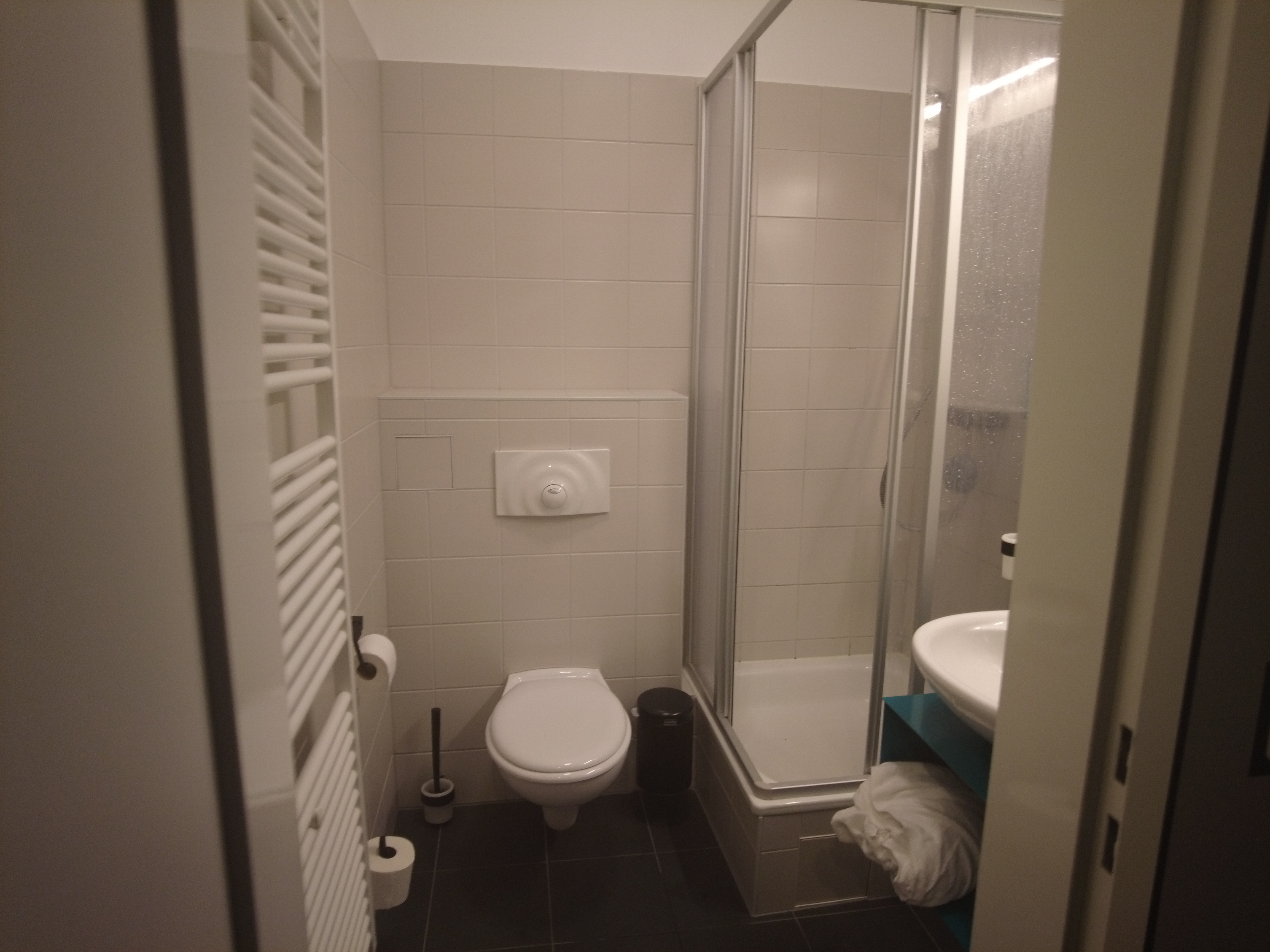
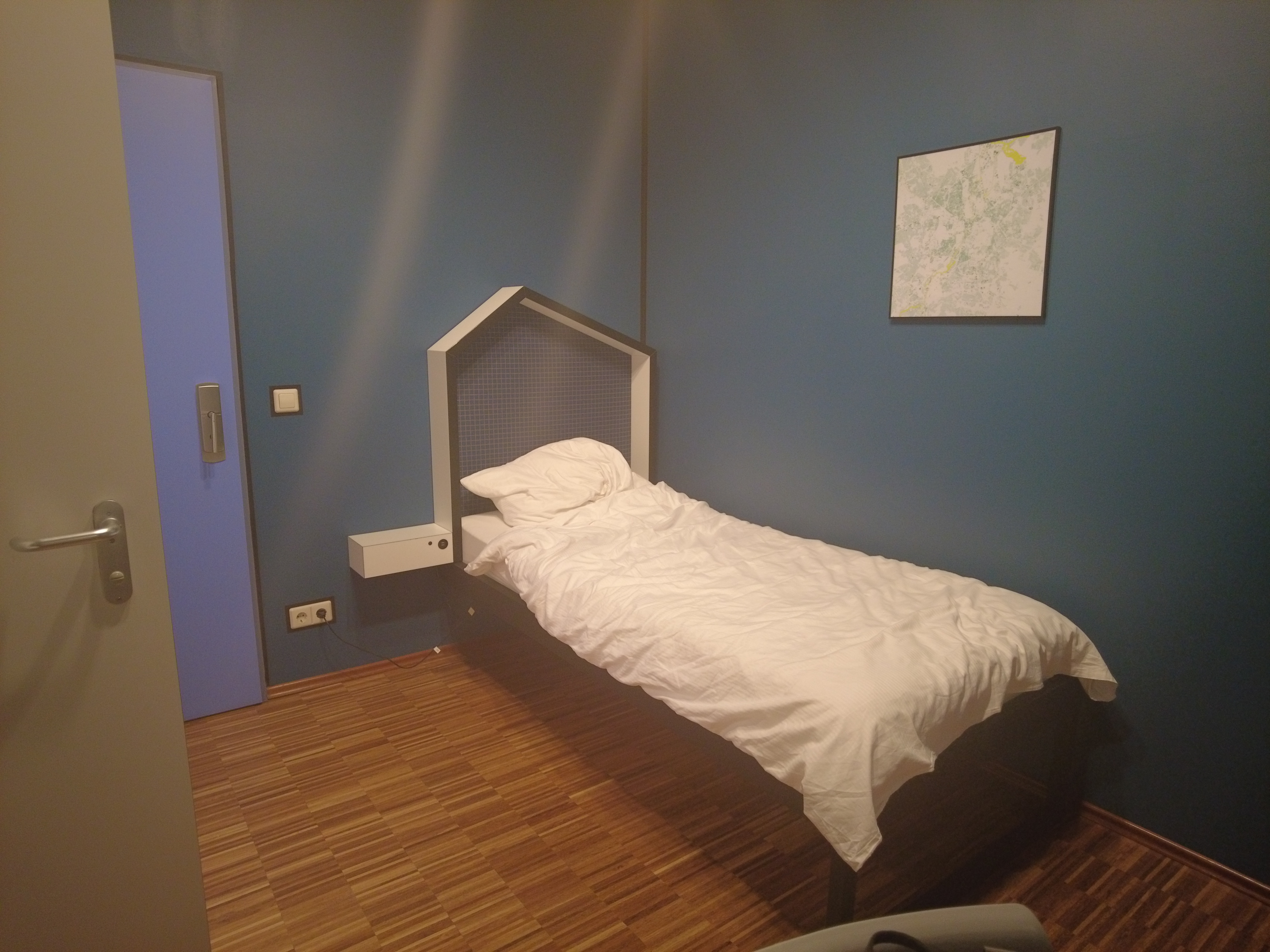
Most of the people hanging in the lobby and the bar looked like young twenty something adults. The bar was pretty nice but crowded in the evening. I used this time to shower and change since at this point it has been over 24 hours since I departed St. Louis. I sat down and filled out two postcards I got for children to send to them later and would have taken a nap but realized I just wasn’t tired. So I charged up devices a bit and departed to explore the East Side Gallery and meetup with the conference organizers and speakers for dinner.
East Side Gallery
Departing from Circus Hostel, I boarded a train and made my way towards the East Side Gallery. It was on my way to dinner so I figured this was the perfect time to visit the area.
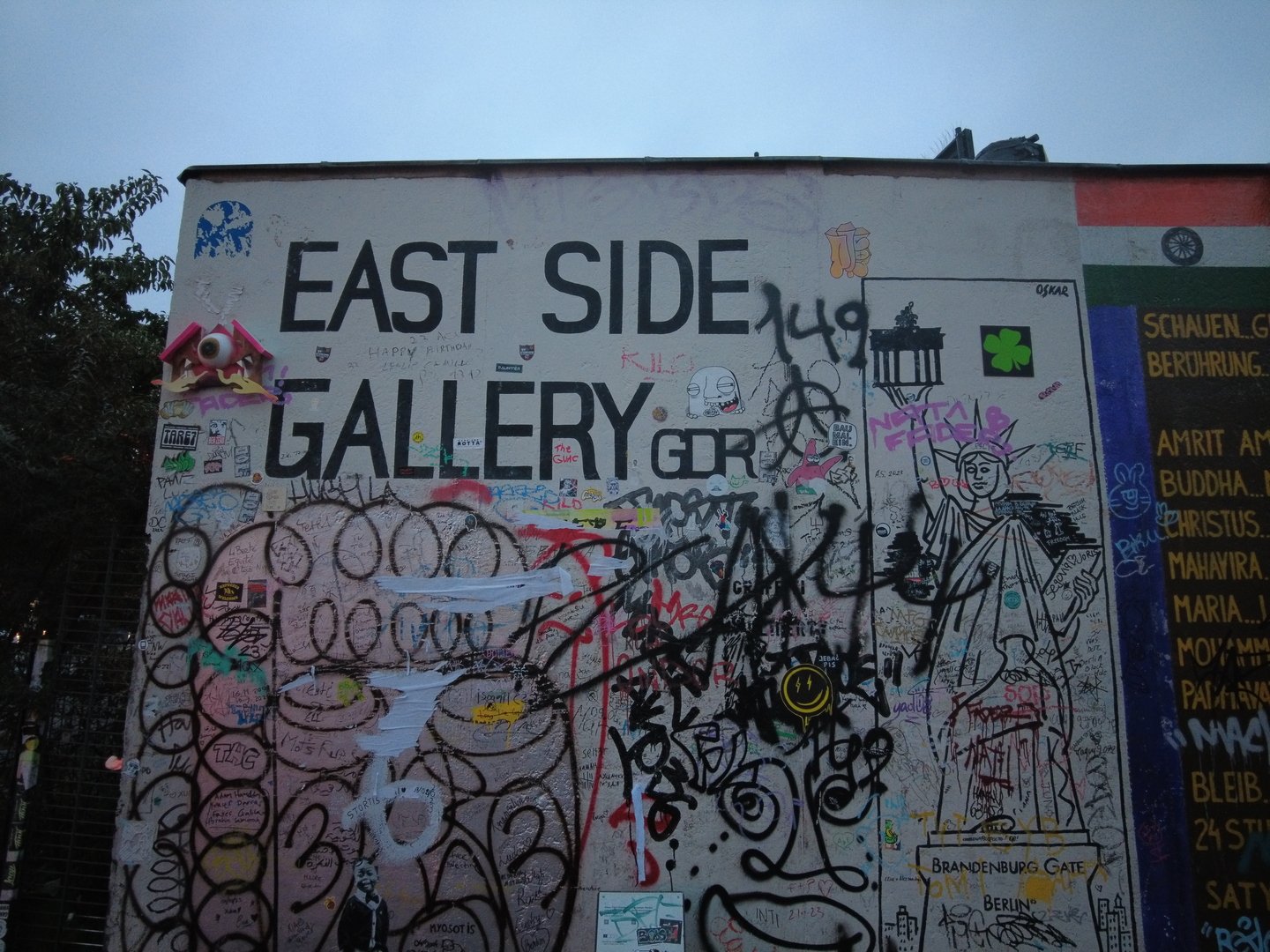

I also stopped at a couple interesting areas on the way, from a boat based hostel to a couple bars and what looked like night clubs. From there, I crossed the bridge and made my way to dinner with the other RabbitMQ Summit speakers.
Overall Impressions About Berlin
I was much more impressed with Berlin than I expected to be. As I had mentioned previously, my expectations were shattered with Rome and as a result I didn’t want to spend a lot of time in Berlin. However I found Berlin to be a lot less crowded and had zero issues with people haggling me as I made my way to attractions like I had in Rome. There is so much to see and explore in the city and if I were to redo this itinerary I like would have spent an additional night or two in Berlin. There’s a lot to do and see!
Onward to Bamberg

The following day in Berlin was spent exclusively at the RabbitMQ Summit (as well as the BEAM Europe Conference in the same space) which I will cover as a separate post, but the day after that I made my way to the Berlin Hbg station to catch my train for Bamberg for the next stop in my trip. See you soon!